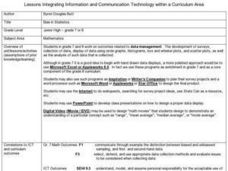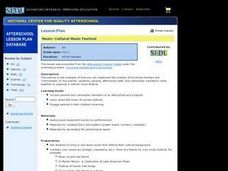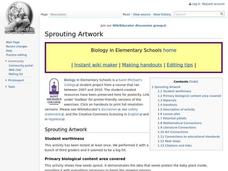Curated OER
World Climate Growing Zones
Young scholars create a map showing where crops would be grown around the world. In this crops lesson plan, students show how the world climate would produce different parts of the world at different times. Young scholars fill out...
Curated OER
Oh Deer!
Students discuss the components necessary to keep animal populations alive . Then they participate in a game where they interact as deer, food, water, and shelter. The activity demonstrates that nature is not static, but changes with the...
Curated OER
Bias in Statistics
Students work to develop surveys and collect data. They display the data using circle graphs, histograms, box and whisker plots, and scatter plots. Students use multimedia tools to develop a visual presentation to display their data.
Curated OER
What's the Difference Between Concentration and Solubility?
High schoolers discuss the difference between concentration and solubility as well as examine the difference in a hands-on activity. Using water and table salt, they experiment with solubility. They create different concentrations using...
Curated OER
Lilly's Big Day
Students read the story Lilly's Big Day and do language arts and math activities based on the book. For this language arts and math lesson plan, students read the book given and do activities that include matching activities, number...
Curated OER
Classroom Identity
Students explore fingerprints. In this finger prints lesson, students investigate how to classify fingerprints. Students study large pictures of fingerprints and circle the patterns they know how to identify. Students then take their own...
Curated OER
Moving Out
Students determine their cost of living. In this determining their cost of living lesson, students think of ten necessary things they would need if they moved out of their parents house. Students research the cost of renting an...
Curated OER
Moon Phases, Day/Night
Fifth graders observe a demonstration that shows how the alignment of the sun, moon, earth relate to the phases of the moon that occur each month. They describe the moon's phases after experimenting in a small group setting and recording...
Curated OER
No Name-Calling Week
Pupils discuss if they have ever heard someone being bullied or called a name; if so, as each child shares, they hold hands and form a linked circle. They then talk about what they can say or do when they witness name-calling or bullying.
Curated OER
Predator and Prey Game
Students explore the why the balance among producers, predators and prey is necessary in order for an ecosystem to be sustained over time. Through web games and activities, they discover how each component of the food chain works to...
Curated OER
Developing Coordination Skills and Pencil Control Using Mouse Hockey
Students explore motor skills by participating in a drawing activity. In this hand coordination lesson, students utilize activity sheets in which they drag their pencil in a specific direction quickly and efficiently. Students utilize...
Curated OER
Reading to Your Child
Learners listen to a story and are encouraged to read. In this reading instructional activity students share tips on reading and complete a group activity.
Curated OER
What's Cooking? It Starts with a Plan and a List
Students create a meal plan for their family. In this adult health science instructional activity, students discuss the benefits of using a shopping list. They explain how these methods can help them save time and make healthy meals.
Curated OER
guided reading using OWLS
Students complete activities based on All About Owls written by Jim Arnosky, Owl At Home written by Arnold Lobel, and Owl Moon written by Jane Yolen.
Curated OER
Cultural Music Festival
Students participate in planning a multi-cultural community event. In this cultural music lesson, parents, community members, and teachers provide time, music, advertisement, and refreshments to create a community multi-cultural music...
Curated OER
To Boldly Go Where No One Has Gone Before
Students study pictures of space vehicles and make their own space vehicle. In this space vehicle lesson, students study pictures of the vehicles and compare and contrast the pictures. Students classify the space crafts and then create...
Curated OER
Sprouting Artwork
Students complete activities to study seeds sprouting and plant growth. In this plant science lesson, students use mustard seeds and sponges to study the seed sprouting process. Students observe their seeds for several days and complete...
Curated OER
Fun with Food: Hola Jalapeno
Students engage in an at-home lesson on language. It contains components that address Adult Education/ESOL, and age appropriate activities for Toddler, Preschool and School aged Students. Adults reinforce steps to prepare tacos in...
Curated OER
Pumpkin Seed Data!
Second graders work with pumpkins to estimate, then accumulate data about pumpkin seeds. After cleaning out the pumpkins, 2nd graders utilize a worksheet imbedded in this plan which has a variety of pumpkin math activities they can do.
Curated OER
Arctic Centers for Kindergarten
Students gain a better understanding of the Arctic, its biology as well as the inhabitants. They then perform activities necessary to develop motor skills, listening and cognitive skills.
Curated OER
Nutrition Unit
First graders complete activities for the six basic food groups. In this food groups lesson, 1st graders view examples of food samples from the various groups and sample the foods. Students discuss the food pyramid and draw a fruit or...
Curated OER
Australian Settlers
Students interpret graphs and research events to identify links between events in the world and the arrival and plight of immigrant groups. They discuss the myths about immigration.
Curated OER
Navigating a Spacecraft
Students work with a partner to plot the trajectory of a spacecraft traveling between Earth and Mars in the 2018 and returning in 2020. They examine the key factors when planning a mission to and from Mars such as travel time, distances...
Curated OER
Pablo Picasso
Fifth graders research Pablo Picasso and apply what they know in a created piece of artwork. They create artwork out of geometric shapes such as triangles, rectangles and circles. They access the Internet to research Picasso and complete...

























